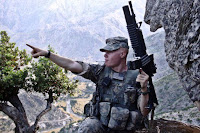Weapons of the War in Afghanistan: Thermal Weapon Sights
Weapons of the War in Afghanistan
Keeping with that theory, let’s take a look at the weapons that have characterized the wars and conflicts that the United States has been a party to over the course of it’s history. During the course of this series, I aim to breakdown the weapons used in each conflict by their classification, and to which party they were employed by. Having served in combat operations in Afghanistan’s Korengal Valley, I would like to start our series with the War in Afghanistan.
For our nineteenth installment let's take a look the most common thermal weapon sights used in the War in Afghanistan.
Part I - The United States
AN/PAS-13 Thermal Weapon Sight (TWS)
The AN/PAS-13 Thermal Weapon Sight (TWS) provides Soldiers with individual and crew served weapons the capability to see deep into the battlefield. It increases surveillance and target acquisition range, and penetrates obscurants either day or night. The TWS systems use uncooled, forward-looking infrared technology. It provides a standard video output for training, image transfer or remote viewing. TWS are lightweight systems that Soldiers can mount on a standard weapon rail and operate beyond the maximum effective range of the weapon.
Product Manager Soldier Maneuver Sensors (PM SMS) is now fielding 17 micron (17um) sensor technology that provides size, weight and power improvements over previous configurations.
The TWS family comprises three variants, each of which is a silent, lightweight, compact, durable and battery-powered thermal sight. They are:
AN/PAS-13(V)1 Light Weapon Thermal Sight (LWTS) for the M16 / M4 series rifles and carbines, as well as the M136 Light Anti-Armor Weapon.
AN/PAS-13(V)2 Medium Weapon Thermal Sight (MWTS) for the M249 Squad Automatic Weapon (SAW) and M240B series Medium Machine Guns.
AN/PAS-13(V)3 Heavy Weapon Thermal Sight (HWTS) for the squad leader’s weapon, M16 / M4 series rifles and carbines, M24 and M107 sniper rifles, and M2 HB and MK19 machine guns.
SPECIFICATIONS:
Performance of fielded 25um systems.
- Weight: HWTS: 3.9 pounds; MWTS: 2.9 pounds; LWTS: 1.9 pounds
- Target recognition range: HWTS: 2,200 meters; MWTS: 1,100 meters; LWTS: 550 meters
- Operational time: HWTS/MWTS: 6.5 hours (six lithium AAs); LWTS: 5 hours (four lithium AAs) at ambient
- Magnification: HWTS: 10x/3.3x (narrow/wide); MWTS: 5x/1.66x (narrow/wide); LWTS: 3.1x/1.55x (narrow/wide)
Performance of latest 17um systems.
- Weight: HWTS: 2.63 pounds; MWTS: 2.17 pounds; LWTS: 1.75 pounds
- Target recognition range: HWTS: 2,200 meters; MWTS: 1,100 meters; LWTS: 550 meters
- Operational time: HWTS/MWTS/LWTS: 20 hours (four lithium L91 AA).
- All variants with one battery change at ambient.
- Magnification: HWTS: 7.98x/2.66x (narrow/wide); MWTS: 3.98x/1.33x (narrow/wide); LWTS: 2x/1x (narrow/ wide)
 |
| Shawn in the Korengal Valley, Kunar Province, Afghanistan. |
For more info on these and other weapons
Technical specs compiled from:
http://armypubs.army.mil/doctrine/Active_FM.html
http://world.guns.ru/index-e.html
https://en.wikipedia.org
http://www.militaryfactory.com/
http://www.olive-drab.com/
http://www.army.mil/
http://dok-ing.hr/products/demining/mv_4?productPage=general
http://www.peosoldier.army.mil/
"The appearance of U.S. Department of Defense (DoD) visual information does not imply or constitute DoD endorsement."
Labels: 1-26 INF, Afghanistan, AN/PAS-13(V) 1, AN/PAS-13(V) 2, AN/PAS-13(V) 3, Cactus Tactical, Firebase Vegas, Korengal Valley, Kunar province, Operation Enduring Freedom, War In Afghanistan, Weapons of War
 |
| Shawn in the Korengal Valley, Kunar Province, Afghanistan. |
For more info on these and other weapons
Technical specs compiled from:
http://armypubs.army.mil/doctrine/Active_FM.html
http://world.guns.ru/index-e.html
https://en.wikipedia.org
http://www.militaryfactory.com/
http://www.olive-drab.com/
http://www.army.mil/
http://dok-ing.hr/products/demining/mv_4?productPage=general
http://www.peosoldier.army.mil/











